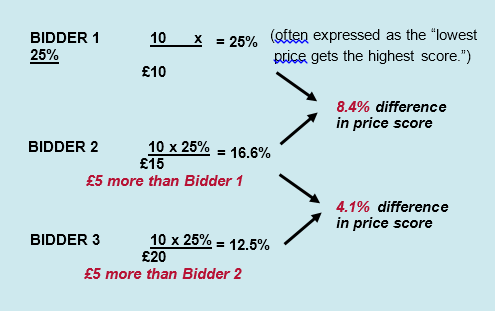08 June 2016
In a previous eUpdate Price scoring - Getting it wrong? I discuss the anomalies thrown up by the use of “relative price scoring formulas”. I show that the use of such formulas may not only lead to potential breaches of public procurement laws, but that they also encourage a “race to the bottom” as tenderers “naturally” wish to obtain the highest score – and they can only do so by pricing as low as they can.
In this eUpdate I explore another type of formula which may prevent, or at least mitigate against, a “race to the bottom”. I also explore whether this formula is more conducive to implementing the social agenda of European institutions and the Scottish Government’s aims of encouraging “fair work practices”; in particular how such scoring formula could be used to deal with the Living Wage.
The Ambitions
The Scottish Government’s ambitions are set out in its “Statutory Guidance on the Selection of Tenders and Award of Contracts – Addressing Fair Work Practices, including the Living Wage, in Procurement” published October 2015 (“the Statutory Guidance”), which is mandatory guidance for contracting authorities undertaking regulated procurements. The Statutory Guidance provides:
- Fair work practices, as well as comprising the Living wage, comprise: “… policies which demonstrate how they (i.e. contractors) comply with relevant employment, equality and health and safety law, human rights standards and adhere to relevant collective agreements.”
- The vision of the Scottish Government: “Public procurement is a key driver of policy development and service delivery which supports sustainable economic growth.”
It is difficult to disagree with the sentiments expressed above, but how can contracting authorities achieve value for money whilst ensuring that economic operators comply with fair work practices that some may regard as financially challenging or too onerous?
The Law
As EU Directives and case law currently stand, to impose a requirement on tenderers to pay the Living Wage may not be compliant with EU legislation. Indeed, the Scottish Government sought clarification from the European Commission on this point (albeit that some commentators queried the need to do so). In light of the Commission’s reply, the Scottish Government’s view, as expressed in the Statutory Guidance, is that:
- “… contracting authorities are unable to make payment of the Living Wage a mandatory requirement as part of a competitive process where the Living Wage is greater than any minimum wage set by or in accordance with law. In the UK, this is the National Minimum Wage.”
- “It is … not possible to reserve any element of the overall tender score specifically to the payment of the Living Wage”.
Where are we with price scoring?
Relative price scoring formulas - mathematical flaws
As we have seen in the first Procurement eUpdate, the standard differential model (a relative scoring formula often used for the price element) contains in-built mathematical flaws. By way of illustration:
Bid 1: £10 Bid 2: £15 Bid: 3 £20
There are three mathematical truths in the above:
(i) The difference between bid 1 and bid 2 is £5;
(ii) The difference between bid 2 and bid 3 is also £5; and
(iii) Bid 3 is twice as expensive as bid 1.
However, applying the standard differential model as shown below:

and assuming a price weighting of 25%, we obtain:

Following the application of the formula, only mathematical truth (iii) above is reflected in these percentage results i.e. Bid 3 is twice as expensive as bid 1 – and conversely the percentage score (12.5%) is half of the maximum percentage allocated (25%).
Had the scores preserved the price differentials (£5 in each case), Bidder 2 would have scored 18.75%, not 16.6%. In other words, the percentage differences between the price scores should be equal to 6.25%, instead of being as highlighted in the diagram above. Bid 2 has, in effect, been “pushed down”.
Fairness, if not logic, dictates that Bidder 2 should have scored 18.75%, not 16.6%. This is even more so where a slightly higher price may be acceptable, or desirable, as an indicator of inclusion of a full range of fair work practices. As it is, Bidder 2 needs to make up a “shortfall” of 2.15% in quality. This is doubly unfair as Bidder 2 may be penalised for factoring in a realistic price in order to ensure fair work practices.
I should point out that the “mean”, or “average”, method is also a relative formula and therefore produces similar inequitable and discriminatory results.
Fair work practices … and The Living Wage
Knowing that relative price scoring formulas:
- Penalise more heavily the offer closest to the best price (as illustrated above);
- Keep tenderers in the dark as regards their own bids;
- Have in-built discriminatory flaws and are non-transparent, (two pillars of European Treaty principles in public procurement);
- Lead to a “race to the bottom”;
and knowing that the most economically advantageous tender is now the sole criterion for selection and that contracting authorities seek to award contracts to economic operators who will meet the laudable aims of achieving fair work practices, including paying the Living Wage, how should contracting authorities procure? Which scoring formulas are best or better?
Contracting Authorities’ Options
Alternative price scoring formulas
Other than the possibilities that have been mooted by some commentators – human rights as a way of seeking the Living Wage in procurement exercises, or the Scottish Government (if legislatively possible) enacting the Living Wage – should contracting authorities not explore what can be referred to as the “optimum price model”?
The formula (see below) may be more appropriate than the standard differential method or the average or mean price model (all relative formulas) if only because the starting point is what the contracting authority has assumed to be a fair price for what it wishes to buy. Tenderers therefore know what the optimal price the buyer is seeking – as well as the maximum price the contracting authority is prepared to pay – and tenderers can match the optimum, come close to it or simply decline to tender as not “financially” viable. The formula in question can be expressed as follows:

Aside from the advantages highlighted above, contracting authorities could proceed by factoring, in their optimal price, fair work practices (that would comprise the Living Wage element) without disclosing the price element or ascribing a score to the built-in cost of fair work practices. In effect, it would be the equivalent, in a way, of factoring in a “life cycle cost”.
Alternative Formulas – Where we want to be
As we have remarked elsewhere, from a legal point of view at least, one of the advantages of the absolute formula is that it is more transparent – it is therefore less likely to breach European treaty principles.
In addition, tenderers are not at the mercy of other submitted bids as a reference point, and bidders know what they require to achieve.
The downside, again as remarked in the first Procurement eUpdate, is that contracting authorities require to carry out market research, gather market intelligence and know what they wish to obtain price-wise.
Finally, the above examples look at price scoring in isolation. Contracting authorities need also to consider how price is evaluated next to (or with), quality before coming to any complete view of the best way forward for any individual procurement exercise. Therefore, while the above takes us part of the way forward, other matters to be considered in future Procurement eUpdates will also be relevant.
Conclusion
If contracting authorities are to deliver fair work practices and the Living Wage though public procurement, then they need to reconsider their tender documentation and tender-assessing procedures – in particular, contracting authorities need to recognise that fair work practices and the Living Wage come at a “price” – economic operators understand this and so should contracting authorities.
It is therefore hoped, given that the lowest price is not now permitted in Scotland under The Public Contracts (Scotland) Regulations 2015, that contracting authorities will move away from flawed scoring formulas that encourage a “race to the bottom”.
In my next eUpdate I will again explore more thoroughly price scoring formulas before analysing, in a future eUpdate the concept of the “most economically advantageous tender”.
If you have any questions in relation to procurement, and this topic in particular, please do not hesitate to call BTO on 0141 221 8012.
Look out for my next eUpdate in this series on “Price Scoring – Does the perfect formula exist?”


